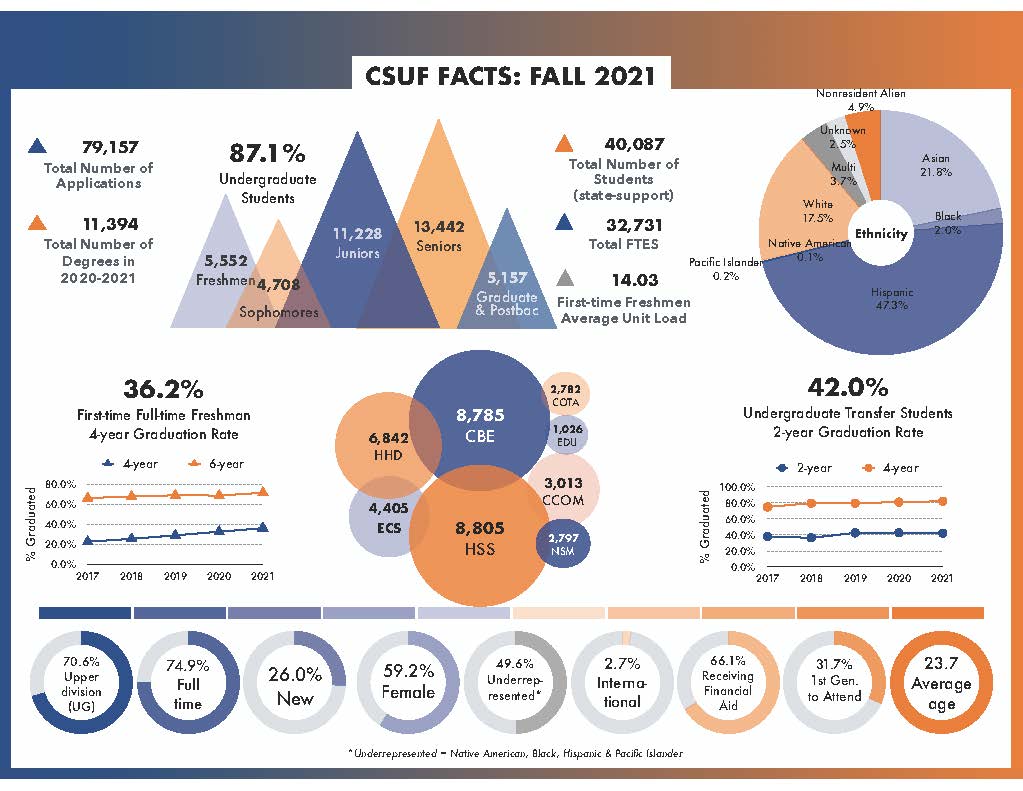Data News
Cal State Fullerton's Student Population Profile for Fall 2021
Despite the challenges associated with the COVID-19 pandemic, Cal State Fullerton's student population grew steadily in many areas.
November 1, 2021
 Many universities across the country are grappling with the effects of COVID-19. Amid this uncertainty, Cal State Fullerton's (CSUF) student population experienced positive gains, including a healthy overall student enrollment. While nationwide enrollment dropped, CSUF's enrollment stabilized at 40,087, reflecting only a small deviation from last fall's enrollment of 41,408. Altogether CSUF received 79,157 total applications, compared to the previous year's 79,443 applications. Among the fall 2021 students, 59.2% of the student population identifies as female, and 49.6% are underrepresented students*. See below for more fall 2021 highlights.
Many universities across the country are grappling with the effects of COVID-19. Amid this uncertainty, Cal State Fullerton's (CSUF) student population experienced positive gains, including a healthy overall student enrollment. While nationwide enrollment dropped, CSUF's enrollment stabilized at 40,087, reflecting only a small deviation from last fall's enrollment of 41,408. Altogether CSUF received 79,157 total applications, compared to the previous year's 79,443 applications. Among the fall 2021 students, 59.2% of the student population identifies as female, and 49.6% are underrepresented students*. See below for more fall 2021 highlights.
-
40,000+ students enrolled at CSUF despite the national higher education enrollment decline.
-
Multiple student populations increased slightly from last fall:
-
Female identified students increased from 58.5 % to 59.2%
-
Underrepresented student populations increased from 48.5% to 49.6%
-
Upper-division student population increased from 69.6% to 70.6%
-
-
Students receiving financial aid increased from 59.7% to 66.1%
-
CSUF experienced two decreases from last fall:
-
International student enrollment decreased from 3.1% to 2.7%
-
Full-time student enrollment decreased from 77.2% to 74.9%
-
-
New largest college: The College of Humanities and Social Sciences is now the largest college with a headcount enrollment of 8,805, narrowly surpassing the College of Business and Economics with a total enrollment of 8,785.
-
Compared to last fall, the First-time freshmen (FTF) average unit load increased from 13.95 to 14.03.
Additionally, CSUF achieved the highest graduation rates for both FTF and transfer students in its history. The FTF four-year graduation rate is 36.2%, and the transfer student two-year graduation rate is 42%. This brings CSUF closer to reaching the GI 2025 graduation rate goals. To learn more about GI 2025, visit the CSU GI2025 website.
The Office of Assessment and Institutional Effectiveness (OAIE) publishes CSUF's student population profile every fall. To view more of CSUF's student population profile across the years, visit the OAIE website.
*Underrepresented Students: African American, American Indian or Native American, Hispanic, and Pacific Islander.
<h3>Cal State Fullerton Celebrates Growth - 9/29/2020</h3>
<p> </p>
<p>As the Fall semester kicks off here at Cal State Fullerton, the Office of Assessment and Institutional Research is proud to share some positivity during these uncertain times.</p>
<p> </p>
<p>It was a record-breaking year for degrees awarded in 2019/2020. The overall number of degrees awarded to Hispanic students (X,XXX) reached a new high. This high included new records for Bachelor’s and Master’s degrees awarded for both Hispanic women and men (see Table 1). The records set are part of a steady incline of Hispanic graduates that have taken place over the last few years. This is a welcomed trend as the University continues to serve as an HSI institution.</p>
<p> </p>
<p>The achievement is also part of larger success for Cal State Fullerton in setting a new record for degrees awarded to underrepresented students (see Figure 1 or Table 2), including any student who has identified their race/ethnicity as African American, American Indian or Native American, Hispanic, or Pacific Islander.</p>
<p> </p>
<p>Cal State Fullerton also ranked as a top 20 Regional West University by US News & World Report. Our accolades in the report include ranking number nine in the social mobility category and number five in the most innovative category. The success in the rise of degrees awarded attributes to social mobility rankings as degrees tend to allow for upward mobility for generations to come.</p>
<p> </p>
<p>Degree data is collected and updated every year. It can be viewed and downloaded via the dashboards on the Office of Assessment and Institutional Research’s website at http://www.fullerton.edu/data/institutionalresearch/ . Viewers can study the trends described in this article and more by exploring the dashboards and adjusting dashboard filters to get specific information. Data from the last eleven years is available and can be used for grant applications, Program Performance Reviews, and more.</p>

